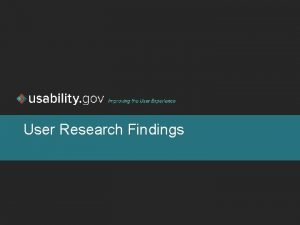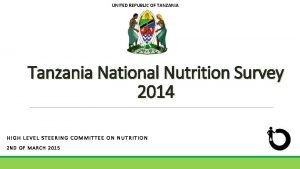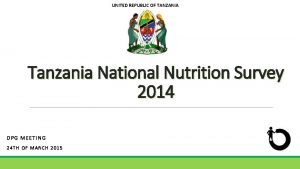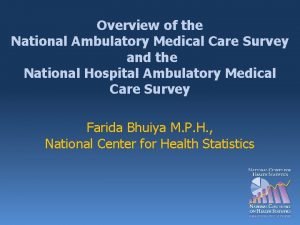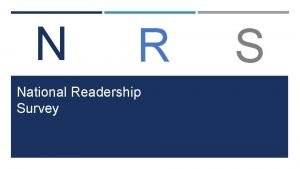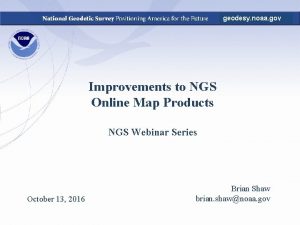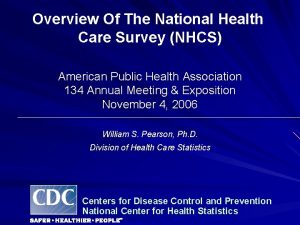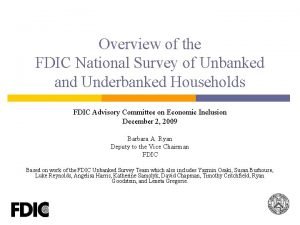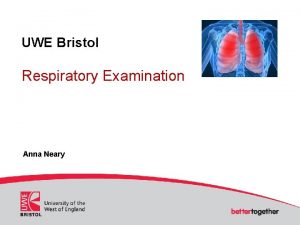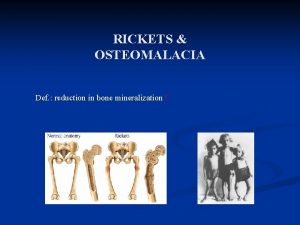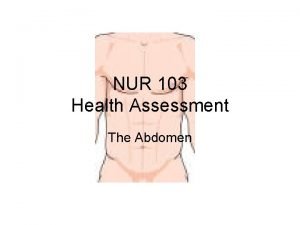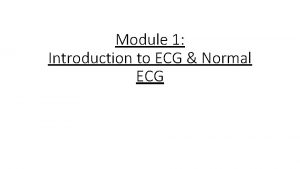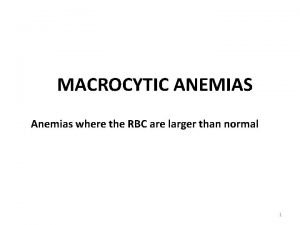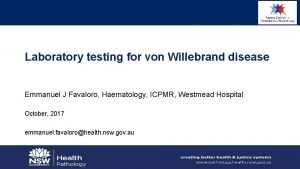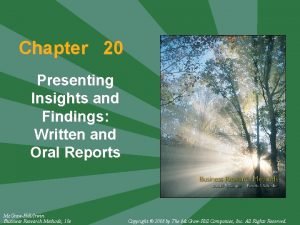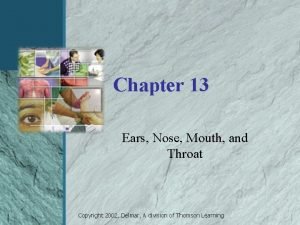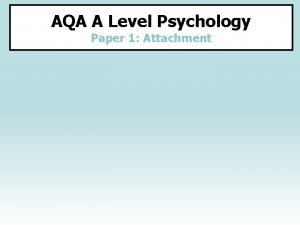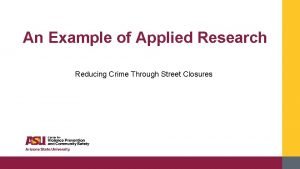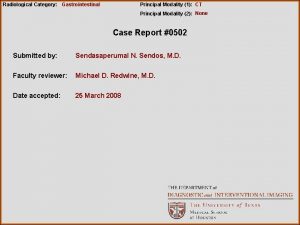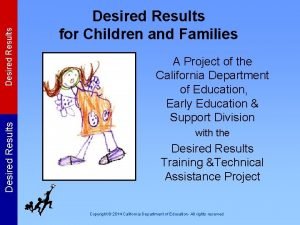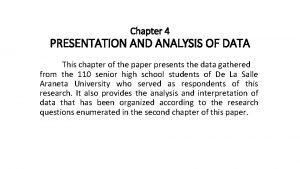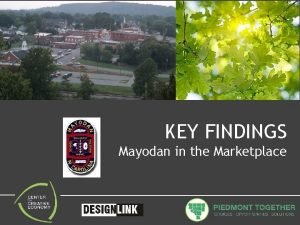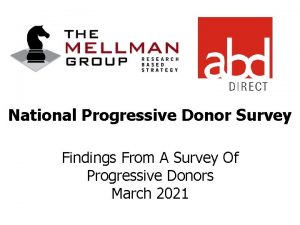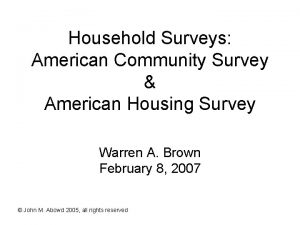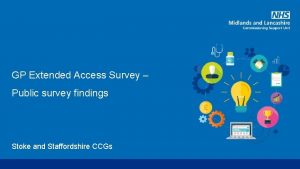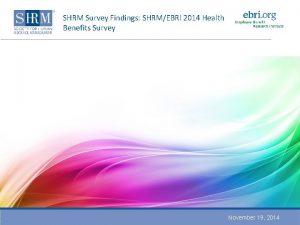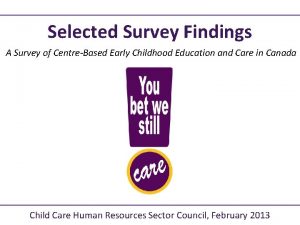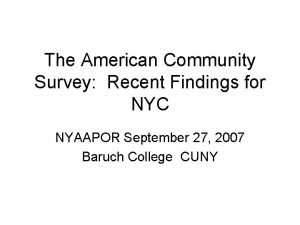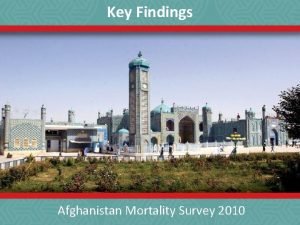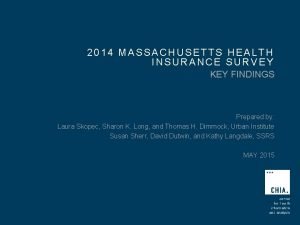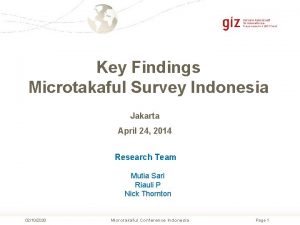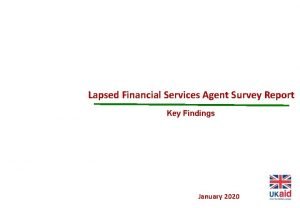National Survey of American Teachers Key Findings from
















































- Slides: 48

National Survey of American Teachers Key Findings from a Survey of 700 Teachers Conducted May 8 -12, 2015

Methodology On behalf of Communities In Schools, Public Opinion Strategies conducted a national online survey of 700 American Teachers. The survey was conducted May 8‐ 12, 2015 and has a margin of error of + 3. 7%. National Teacher Survey – MAY 2015

Perceptions of Their Local Schools

While most teachers believe their local schools are doing OK, a plurality believe education quality has “gotten worse” over the past few years. First, generally speaking, when it comes to your local public school, do you think the school in which you teach is working pretty well now, some changes are needed but basically should be kept the same, major changes are needed, or a complete overhaul is needed? 75% And, when you think about your local public school, do you believe the quality of education for students has gotten better, gotten worse, or stayed about the same over the past few years? +51 -8 24% Working Well/ Some Changes Major Changes/ Complete Overhaul Total National Teacher Survey – MAY 2015 30% Better 38% 29% Worse Same Total 4

Younger teachers are more likely to say the quality of education has "gotten worse. " And, when you think about your local public school, do you believe the quality of education for students has gotten better, gotten worse, or stayed about the same over the past few years? By Age -6 -8 38% 32% -16 +2 41% 38%36% 30% 25% 27% 35%34% 27% Better Worse Same 18 -34 (27%) 35 -44 (25%) 45 -54 (25%) 55+ (22%) National Teacher Survey – MAY 2015 5

But, interestingly, it's also newer teachers who seem more optimistic. And, when you think about your local public school, do you believe the quality of education for students has gotten better, gotten worse, or stayed about the same over the past few years? By Time In Education +3 -11 38% 34%31% 33% 30% 27% -15 -2 43% 34%36% 28% 26% Better Worse Same <5 Years (18%) 5 -10 Years (21%) 10 -20 Years (34%) 20+ Years (27%) National Teacher Survey – MAY 2015 6

There’s some key regional differences as well. And, when you think about your local public school, do you believe the quality of education for students has gotten better, gotten worse, or stayed about the same over the past few years? By Region -22 -5 -7 West +4 Midwest Northeast 46% 24% 37% 36%34% 37% 33% 32% 29% 28% 27% South B W S Northeast (22%) B W South (38%) S B W S Midwest (22%) B W S West (18%) National Teacher Survey – MAY 2015 7

Problems Facing Their Local Schools

Teachers point to "too much testing" as the biggest problem facing public schools. And, which TWO of the following do you believe are the biggest problems facing the public school in which you teach? Total 48% Too much testing 35% Lack of parental involvement Students coming to school distracted by problems from outside of school 30% Students generally disengaged with learning 28% 27% Class sizes are too large 19% Poor administrative leadership The poverty level of students 13% National Teacher Survey – MAY 2015 9

There are some differences in problem perception by teacher ethnicity. And, which TWO of the following do you believe are the biggest problems facing the public school in which you teach? Among Whites Among African-Americans 51% Too much testing 34% Lack of parental involvement 29% Class sizes are too large Students generally disengaged with learning 29% Students generally disengaged with learning Poor administrative leadership The poverty level of students 25% 19% 13% 39% Too much testing Students coming to school distracted by problems from outside of school Class sizes are too large 39% Lack of parental involvement 33% 30% Students coming to school distracted by problems from outside of school 27% 26% Poor administrative leadership The poverty level of students 5% National Teacher Survey – MAY 2015 Among Hispanics Students coming to school distracted by problems from outside of school 42 40% Too much testing Class sizes are too large Lack of parental involvement The poverty level of students 32% 27% 23% Poor administrative leadership 20% Students generally disengaged with learning 17% 10

Teachers report that lack of parental involvement and student apathy are the most serious problems facing their local public schools. Next, please read through the following list, and indicate if each issue is a serious problem, moderate problem, minor problem, or not a problem at all for your local school district… % Serious Problem Total 38% Lack of parental involvement in your students’ education 92% 31% Student apathy* 92% 26% Disruptive student behavior in school^ 92% 25% The poverty level of students is a barrier to learning 88% 22% Chronic absenteeism from school 89% 13% 73% Student violence^ 11% 72% Poor student health and diet 11% Students dropping out of school 11% Student drug use* Student pregnancy 6% 85% 68% 55% *Asked of Sample A, N=350 National Teacher Survey – MAY 2015 ^Asked of Sample B, N=350 11

Serious Problem Grid Total 18 -34 (27%) 35 -44 (25%) 45 -54 (25%) 55+ (22%) <5 Years (18%) 5 -10 Years (21%) 10 -20 Years (34%) 20+ Years (27%) Elementary (34%) Middle School (20%) High School (27%) Other/ Support (19%) White (82%) Lack of parental involvement 38% 35% 45% 36% 35% 40% 38% 41% 32% 36% 45% 33% 40% 36% 42% 52% Student apathy* 31% 28% 26% 38% 31% 35% 23% 36% 28% 24% 31% 44% 24% 30% 28% 47% Disruptive student behavior in school^ 26% 33% 30% 24% 18% 30% 27% 26% 23% 27% 33% 22% 24% 54% 35% The poverty level of students 25% 24% 29% 24% 21% 24% 26% 26% 27% 15% 33% 24% 41% Chronic absenteeism from school 22% 29% 22% 13% 27% 24% 21% 18% 19% 20% 28% 21% 23% 32% Student drug use* 13% 19% 12% 9% 11% 22% 15% 12% 6% 13% 10% 16% 11% 12% 9% 30% Poor student health and diet 11% 13% 11% 12% 8% 15% 14% 9% 10% 13% 11% 8% 13% 9% 15% 32% Student violence^ 11% 16% 12% 10% 6% 19% 10% 13% 9% 12% 11% 10% 28% 19% Students dropping out of school 11% 14% 10% 9% 16% 14% 8% 10% 15% 5% 9% 13% 8% 18% 32% Student pregnancy 6% 12% 5% 5% 2% 11% 10% 4% 3% 11% 3% 4% 5% 5% 15% 21% % Serious Problem *Asked of Sample A, N=350 African. Hispanic American (7%) (6%) ^Asked of Sample B, N=350 National Teacher Survey – MAY 2015 12

Serious Problem Grid Total Northeast (22%) South (38% Midwest (22%) West (18%) Urban School Setting (26%) Suburban School Setting (52%) Rural School Setting (22%) Lack of parental involvement 38% 35% 43% 32% 37% 46% 35% 34% Student apathy* 31% 30% 31% 26% 38% 28% 33% 28% Disruptive student behavior in school^ 26% 32% 16% 27% 39% 22% The poverty level of students 25% 22% 29% 18% 26% 34% 20% 24% Chronic absenteeism from school 22% 23% 22% 19% 24% 30% 18% 21% Student drug use* 13% 20% 11% 12% 16% 14% 8% Poor student health and diet 11% 12% 14% 7% 11% 18% 9% 10% Student violence^ 11% 14% 7% 8% 22% 8% 7% Students dropping out of school 11% 14% 9% 7% 16% 22% 8% 5% Student pregnancy 6% 6% 7% 4% 9% 12% 4% 5% % Serious Problem *Asked of Sample A, N=350 ^Asked of Sample B, N=350 National Teacher Survey – MAY 2015 13

Teachers in Support Roles

On average, teachers say they are currently spending about 20% of their time helping students with problems they face outside of the classroom. And, if you had to guess, what percentage of time do you spend helping students with problems they face at home/outside the classroom? 0‐ 10% 45% 11‐ 20% 23% 21‐ 30% 31‐ 40% 15% 7% 41‐ 50% 6% 51‐ 60% 1% 61‐ 70% 71‐ 80% 1% 81‐ 90% 2% 0% 91‐ 100% 1% National Teacher Survey – MAY 2015 20% Mean 15

Series 1 Younger and less experienced teachers tend to spend more of their time on helping students with problems outside of the classroom. And, if you had to guess, what percentage of time do you spend helping students with problems they face at home/outside the classroom? Mean % by Age Mean % by Time in Education 24. 9 20. 5 19. 5 24. 2 21. 5 17. 4 17. 2 16. 8 18 -34 (27%) 35 -44 (25%) 45 -54 (25%) 55+ (22%) <5 Years (18%) National Teacher Survey – MAY 2015 5 -10 Years 10 -20 Years (21%) (34%) 20+ Years (27%) 16

Series 1 And, African-American and Hispanic teachers are spending more time on non-academic problems than white teachers. And, if you had to guess, what percentage of time do you spend helping students with problems they face at home/outside the classroom? Mean % by Ethnicity 31. 3 18. 7 White (82%) African-American (6%) National Teacher Survey – MAY 2015 27. 8 Hispanic (7%) 17

Nearly all teachers report they have paid money out of their own pocket for school supplies. And, in the last few years, in your role as a teacher, have you personally done any of the following… Paid money out of your own pocket for classroom supplies? 91% +82 9% Yes No Total National Teacher Survey – MAY 2015 18

Many teachers have also paid money out of their own pocket to help feed a student, assisted a student through a crisis, and even arranged for a student to get new clothing. And, in the last few years, in your role as a teacher, have you personally done any of the following… Paid money out of your own pocket to help feed a student Assisted a student and/or their family through a crisis Arranged for a student to get new clothing or footwear +8 +4 -2 54% 46% Yes No Total 52% 48% 49% 51% No Yes Total National Teacher Survey – MAY 2015 Total 19

Nearly one-third of teachers say they have arranged for a student to receive medical attention. And, in the last few years, in your role as a teacher, have you personally done any of the following… Arranged for a student to receive medical attention? -42 71% 29% Yes No Total National Teacher Survey – MAY 2015 20

And, 14% of teachers say they have helped a student find a safe place to stay. And, in the last few years, in your role as a teacher, have you personally done any of the following… Helped a student find a safe place to stay? By School Setting By Ethnicity Overall -7286% -7487% -40 -68 84% 70% 30% 14% 16% 13% -58 79% 21% 93% -7286% -86 14% 7% Yes No Yes No Total White (82%) African-American (6%) Hispanic (7%) Urban (26%) Suburban (52%) Rural (22%) National Teacher Survey – MAY 2015 21

Potential Changes to Local School Districts

There’s strong support among teachers to implement programs that empower students to stay in school and achieve success. Next, please consider the following potential changes that could be made in your own local school district. For each one, please indicate if you would strongly favor, somewhat oppose or strongly oppose that proposed change. . . Implement programs that empower students to stay in school and achieve success? 95% +93 66% Strongly Oppose 2% Favor Total National Teacher Survey – MAY 2015 23

Teachers support both school-based AND community-based resources to help meet student needs. Next, please consider the following potential changes that could be made in your own local school district. For each one, please indicate if you would strongly favor, somewhat oppose or strongly oppose that proposed change. . . Provide school-based resources to help meet student needs* Provide community-based resources to help meet student needs^ +84 +92 90% 95% 59% Strongly 56% Strongly Oppose 6% Favor Total *Asked of Sample A, N=350 3% Total ^Asked of Sample B, N=350 National Teacher Survey – MAY 2015 24

Teachers strongly support providing dedicated professional staff from the local community to work with students AND organizations that work inside schools to help students with non-academic needs. Next, please consider the following potential changes that could be made in your own local school district. For each one, please indicate if you would strongly favor, somewhat oppose or strongly oppose that proposed change. . . Provide dedicated professional staff from the local community to work closely with students and families with the greatest needs. 94% Support organizations/individuals that work inside schools to help kids with non-academic needs. 92% +91 57% Strongly +88 57% Strongly Oppose 3% Favor Total National Teacher Survey – MAY 2015 Oppose 4% Favor Total 25

And, there's strong support for both utilizing partnerships between schools and the private sector to provide assistance with at-risk students AND for involving schools with community groups. Next, please consider the following potential changes that could be made in your own local school district. For each one, please indicate if you would strongly favor, somewhat oppose or strongly oppose that proposed change. . . Utilize partnerships between schools and the private sector to provide assistance with at-risk students. * Involve schools with community groups that connect caring professionals with at-risk students. ^ +87 +92 91% 95% 58% Strongly 55% Strongly Oppose 4% Favor Total *Asked of Sample A, N=350 Oppose 3% Favor Total ^Asked of Sample B, N=350 National Teacher Survey – MAY 2015 26

Support for Non‐Academic Barriers

Teachers believe it is both very important AND very valuable to them personally to have people dedicated solely to addressing non-academic barriers to student learning. How important would it be for your local school district to have staff people dedicated solely to addressing non‐academic barriers to student learning often associated with poverty? * 90% How valuable would it be for you personally to have staff people in your local school district dedicated solely to addressing non‐academic barriers to student learning often associated with poverty? +81 93% +88 55% Very 50% Very % INTENSITY 9% Important Not Important Total *Asked of Sample A, N=350 5% Valuable Not Valuable Total ^Asked of Sample B, N=350 National Teacher Survey – MAY 2015 28

By nearly two-to-one, teachers believe the job of addressing these support services is better left up to dedicated professionals brought into schools from the community. And, generally speaking, is it the job of your local school district to provide these types of support services or is that a job better left up to dedicated professionals who are brought into the school from the community? +20 48% 28% Professionals From Community Local School District Total National Teacher Survey – MAY 2015 29

Older teachers and more experienced are more likely to support dedicated professionals over existing school resources. And, generally speaking, is it the job of your local school district to provide these types of support services or is that a job better left up to dedicated professionals who are brought into the school from the community? By Age -6 +17 By Time in Education +33 54% +44 +3 +16 +20 61% +37 56% 48% 46% 44% 43% 41% 40% 35%29% 28% 21% 17% 19% Local Prof School From District Comm Local Prof School From District Comm 18 -34 (27%) 35 -44 (25%) 45 -54 (25%) 55+ (22%) <5 Years (18%) National Teacher Survey – MAY 2015 Local Prof School From District Comm 5 -10 Years 10 -20 Years (21%) (34%) Local Prof School From District Comm 20+ Years (27%) 30

White teachers think dedicated professionals are better, while attitudes among minority teachers are more divided. And, generally speaking, is it the job of your local school district to provide these types of support services or is that a job better left up to dedicated professionals who are brought into the school from the community? By Ethnicity +24 -6 50% 45% +5 39% 26% 37% 42% Professionals Local School From District Community White (82%) African-American (6%) Hispanic (7%) National Teacher Survey – MAY 2015 31

Teachers across school location would rather have dedicated professionals. And, generally speaking, is it the job of your local school district to provide these types of support services or is that a job better left up to dedicated professionals who are brought into the school from the community? By School Setting +7 35% +25 52% 50% 42% 25% 27% Professionals Local School From District Community Urban (26%) Suburban (52%) Rural (22%) National Teacher Survey – MAY 2015 32

Both union and non-union members would rather have dedicated professionals. And, generally speaking, is it the job of your local school district to provide these types of support services or is that a job better left up to dedicated professionals who are brought into the school from the community? By Teachers' Union +18 +24 51% 46% 28% Local School District 27% Professionals From Community Member of Teachers' Union (60%) National Teacher Survey – MAY 2015 Local School District Professionals From Community Not Member of Teachers' Union (40%) 33

And, a significant majority of teachers indicate it would be more effective to have this support come from dedicated professionals rather than from existing school resources. And, as a teacher, do you believe it would be more effective to have these types of support services for students come from existing school resources and staff OR from dedicated professionals who are brought into the school from the community? +36 59% 23% Professionals From Community Existing Resources and Staff Total National Teacher Survey – MAY 2015 34

Older teachers and more experienced are more likely to say it’d be more efficient to have dedicated professionals over existing school resources. And, as a teacher, do you believe it would be more effective to have these types of support services for students come from existing school resources and staff OR from dedicated professionals who are brought into the school from the community? By Age +11 +41 By Time in Education +39 +55 +8 62% 61% 67% 46% 35% 21% 22% Existing Prof Resource From & Staff Comm 18 -34 (27%) Existing Prof Resource From & Staff Comm 35 -44 (25%) Existing Prof Resource From & Staff Comm 45 -54 (25%) 12% Existing Prof Resource From & Staff Comm 55+ (22%) +30 +46 55% 46% 38% 25% Existing Prof Resource From & Staff Comm <5 Years (18%) National Teacher Survey – MAY 2015 Existing Prof Resource From & Staff Comm +46 64% 63% 18% 17% Existing Prof Resource From & Staff Comm 5 -10 Years 10 -20 Years (21%) (34%) Existing Prof Resource From & Staff Comm 20+ Years (27%) 35

Teachers across ethnicity are in the dedicated professional camp. And, as a teacher, do you believe it would be more effective to have these types of support services for students come from existing school resources and staff OR from dedicated professionals who are brought into the school from the community? By Ethnicity +39 +20 60% +9 54% 34% 40% 49% 21% Existing Professionals From Resources Community & Staff White (82%) Existing Professionals Resources From & Staff Community African-American (6%) National Teacher Survey – MAY 2015 Existing Professionals Resources From & Staff Community Hispanic (7%) 36

Teachers across all school locations believe it would be more effective to have dedicated professionals. And, as a teacher, do you believe it would be more effective to have these types of support services for students come from existing school resources and staff OR from dedicated professionals who are brought into the school from the community? By School Setting +21 +40 62% 49% 28% Existing Professionals From Resources Community & Staff Urban (26%) 21% Existing Professionals Resources From & Staff Community Suburban (52%) National Teacher Survey – MAY 2015 22% Existing Professionals Resources From & Staff Community Rural (22%) 37

And, both union and non-union members say it’d be more effective to have dedicated professionals. And, as a teacher, do you believe it would be more effective to have these types of support services for students come from existing school resources and staff OR from dedicated professionals who are brought into the school from the community? By Teachers' Union +39 +30 59% 27% 20% Existing Resources & Staff 57% Professionals From Community Member of Teachers' Union (60%) National Teacher Survey – MAY 2015 Existing Resources & Staff Professionals From Community Not Member of Teachers' Union (40%) 38

After teachers hear from both sides… Now, please read each of the following statements… Some people say that non‐academic support issues should be primarily handled by the local school district with existing school resources. They say that public education systems in our communities are dying and are being dismantled by profit‐making corporations. Because of this, they believe local school districts should take the lead, using their financial resources to make schools the centers of their communities and providing students, families and neighbors with support services. Other people say that non‐academic support issues should be primarily handled by dedicated professionals from the community working within the school. They say that teachers should be able to focus on teaching, not poverty, and that we should be making sure our limited education funding stays where it’s needed the most – classroom instruction. And, they say that professionals outside of the school system are better suited to deliver these non‐academic support services. Now, after reading both statements, please indicate whether you believe it would be more effective to have these types of support services for students come from existing school resources and staff OR from dedicated professionals who are brought into the school from the community? National Teacher Survey – MAY 2015 39

Even more teachers say it would be more effective to have support services come from dedicated professionals in the community. Please indicate whether you believe it would be more effective to have these types of support services for students come from existing school resources and staff OR from dedicated professionals who are brought into the school from the community? Initial Informed +36 +40 62% 59% 23% 22% Professionals From Community Existing Resources & Staff Total National Teacher Survey – MAY 2015 Professionals From Community Existing Resources & Staff Total 40

Perceptions of Communities In Schools

Fully one-quarter of teachers report they have Communities In Schools in their school. In your local school district, do you happen to have Communities In School, a program which links community resources and provides services to students in your school? Overall 47% 25% 28% By School Setting By Ethnicity 50% 22% 28% 58% 19%23% 39% 37% 34% 31%31% 29% 48% 21% 30% 56% 24% 20% Not Yes No Sure Not Yes No Sure Total White (82%) African-American (6%) Hispanic (7%) Urban (26%) Suburban (52%) Rural (22%) National Teacher Survey – MAY 2015 42

After those teachers without CIS in their school hear more about it… Communities In Schools is a locally based non‐profit organization that brings community resources inside public school buildings to help individual students in need and prevent students from dropping out of school. Communities In Schools has an effective, evidence‐based model of preventing students from dropping out of school. Based on this description, do you have a favorable or unfavorable impression of Communities in Schools? National Teacher Survey – MAY 2015 43

They are very receptive. Based on this description, do you have a favorable or unfavorable impression of Communities In Schools? * 82% +79 Unfavorable 3% Favorable Total *Asked if “No” or “Not Sure” of program, N=523 National Teacher Survey – MAY 2015 44

Teachers with CIS in their school districts view CIS very favorably. And, based on what you know, do you have a favorable or unfavorable impression of Communities In Schools? * Overall +75 79% Fav 79% Unfav 4% Total By School Setting By Ethnicity Fav 4% White (70%) +66 70% 4% African-American (14%) +81 81% Fav 0% Hispanic (11%) +72 76% Fav 4% Urban (35%) +76 79% Fav 3% Suburban (44%) +78 82% Fav 4% Rural (21%) *Asked if they have program in school, N=177 National Teacher Survey – MAY 2015 45

And, those teachers believe CIS has been very helpful for their local school district. And, in your opinion, how helpful has Communities In Schools been for your local school district? * Overall +73 81% By Ethnicity +68 78% 100% +75 +100 79% By School Setting +60 74% 85%+81 84%+77 61% Very 36% Very 31% Very 8% 37% Very 23% Very 10% Not Helpful Total White (70%) 14% 4% Helpful African-American (14%) Helpful 0% Hispanic (11%) Not Helpful Urban (35%) 38% Very 23% Very 7% 4% Helpful Suburban (44%) Helpful Rural (21%) *Asked if they have program in school, N=177 National Teacher Survey – MAY 2015 46

Interestingly, teachers aren't really sure whether CIS is part of the school from the inside or an outside organization. And, from what you know about Communities In Schools, is it part of the school from the inside or are they an outside organization? Overall +8 By School Setting By Ethnicity +1 +20 +30 +22 -12 +31 65% 46% 40% 38% 41% 16% 19% 60% 55% 53% 35% 45% 33% 29% 22% 13% Part Out. Of side Not School Org Sure Total White (70%) African-American (14%) 12% Part Out. Of side School Org 0% Hispanic (11%) Part Out. Of side Not School Org Sure Urban (35%) Suburban (44%) 10% Part Out. Of side Not School Org Sure Rural (21%) *Asked if they have program in school, N=177 National Teacher Survey – MAY 2015 47

214 North Fayette Street Alexandria, Virginia 22314 Phone: (703) 836 -7655 Web: www. pos. org
 Kim kroll
Kim kroll Example of findings in research
Example of findings in research Secondary abcd
Secondary abcd National association of special education teachers
National association of special education teachers American statistical association salary survey
American statistical association salary survey Key suppliers business model canvas
Key suppliers business model canvas Contoh bisnis model canvas makanan pdf
Contoh bisnis model canvas makanan pdf Tanzania national nutrition survey 2018
Tanzania national nutrition survey 2018 Tanzania national nutrition survey 2020
Tanzania national nutrition survey 2020 National ambulatory medical care survey
National ambulatory medical care survey Pamco survey
Pamco survey Ngs cors map
Ngs cors map National hospital care survey
National hospital care survey National survey of unbanked and underbanked households
National survey of unbanked and underbanked households National soil survey center
National soil survey center Singapore national nutrition survey
Singapore national nutrition survey Chapter 10 qualitative research designs
Chapter 10 qualitative research designs Tactile.fremitus
Tactile.fremitus Communication of research findings
Communication of research findings What is quantitative example
What is quantitative example Throax
Throax Rickets def
Rickets def Qualitative research results and discussion
Qualitative research results and discussion Pneumothorax auscultation findings
Pneumothorax auscultation findings To understand and interpret social interactions
To understand and interpret social interactions Recommendation in research example
Recommendation in research example 4 quadrants of abdomen
4 quadrants of abdomen Acute interstitial nephritis urine findings
Acute interstitial nephritis urine findings Ecers summary of findings
Ecers summary of findings No p wave on ecg
No p wave on ecg Megaloblastic anemia
Megaloblastic anemia Megaloblast vs normoblast
Megaloblast vs normoblast Von willebrand disease test
Von willebrand disease test Presenting insights and findings using written reports
Presenting insights and findings using written reports Nose assessment normal findings
Nose assessment normal findings Law of continuity psychology attachment
Law of continuity psychology attachment Aplastic anemia lab findings
Aplastic anemia lab findings Pathophysiology of aplastic anemia
Pathophysiology of aplastic anemia Folate deficiency symptoms
Folate deficiency symptoms Research findings example
Research findings example What do the findings of roper's experiment suggest?
What do the findings of roper's experiment suggest? Urethitis
Urethitis Hyperphosphatesia
Hyperphosphatesia Announcing your findings
Announcing your findings Meniscus sign intussusception
Meniscus sign intussusception Desired results parent survey
Desired results parent survey Chapter 4 data analysis and findings
Chapter 4 data analysis and findings The jesus seminar findings
The jesus seminar findings Nutrition focused physical exam / examination
Nutrition focused physical exam / examination

